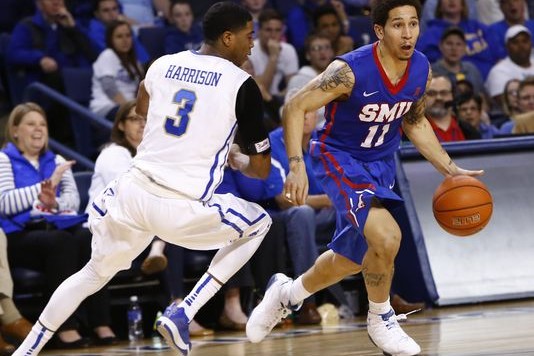In our overview of the RPI on Monday, we put forth the contention that the RPI must die. We now set about the task of offering case studies to more precisely show why this tool — while not the only one or even the primary one the Selection Committee uses — needs to be blown up. It should have no part whatsoever in the selection process.
You’re not going to find a much better example of the RPI’s flaws than SMU — not just this season, but last season as well. One cannot look at SMU’s 2015 season in isolation; examining the Mustangs’ 2014 season alongside 2015 enables the RPI’s weaknesses to emerge in full.
*
A comparison of SMU’s 2014 and 2015 seasons reveals the strange ways in which on-court results accompany the contours of a team’s schedule, producing a given RPI number. You might have your own opinion about what should or shouldn’t get a team into the NCAA tournament, but you cannot deny that a straight RPI rating can very easily have little to no correlation with a team’s level of actual quality.
We start this comparison of SMU’s 2014 and 2015 seasons by noting the complexion of the Mustangs’ conference, The American, in each campaign. Conference play represents the non-discretionary part of any college team’s schedule. Yet, it makes up a majority of what is generally a 30-game schedule. If a team plays deep into its conference tournament, it will wind up playing as many as 21 conference games (and 34 games overall) before Selection Sunday. Even though college basketball teams — when compared to football teams — have much less of an excuse for scheduling poorly out of conference (since they have so many more scheduling slots to fill), it remains that conference play still carries a lot of weight. If you’re in a good league with many good teams, you’ll get a lot more chances to accumulate quality wins. If you play in a barren league, you not only receive fewer bites at the (big-win) apple; any games you lose carry a much greater negative weight, dragging down your profile.
SMU’s 2014 season in The American represented a curious mixture of outstanding wins and awful losses. The American was strong in its upper half and terrible in its lower half. SMU scored four wins against the upper half (Cincinnati, Memphis, two against Connecticut) and suffered three losses against the lower half (South Florida, Temple, Houston). SMU, in its conference, produced a “busy” resume, one with a lot of plot complications for better or worse. Statement wins and gack-attack losses offered a cluttered picture of the 2014 Ponies — they achieved richly and beat NCAA tournament teams on four occasions, but they also stumbled three times against bottom-feeders.
The 2015 team’s profile is substantially different from the 2014 squad as far as conference competition is concerned. The American is a much different — and far weaker — league compared to last year’s iteration.
In 2014, The American was saddled with Rutgers, but it also had Louisville in the mix to bolster the league’s overall heft. UConn was a solid team (during the regular season), as was Memphis. Cincinnati, still a probable NCAA tournament team this season, was a 5 seed last season (and many thought the Bearcats should have been seeded fourth). The American owned five formidable teams: Louisville, UConn, Memphis, Cincy, and SMU. The bottom five — UCF, South Florida, Houston, Rutgers, and Temple — were really bad. (Temple was 179th in the RPI as of Selection Sunday, a fall-off-the-map season for the normally solid Owls.)

Rick Pitino and Louisville made The American a much stronger league in 2014 compared to the current 2015 version. Sure, SMU leads the conference this season, but it achieved a lot more in the 2014 campaign. Why is 2015 SMU’s RPI at 18 while last season’s team carried an RPI of 53 into Selection Sunday? The answer becomes very obvious as you continue to read this piece… and no, it’s not about winning games, either.
This year, Rutgers left to go to the Big Ten and Louisville moved to the ACC. In came Conference USA refugees Tulsa, Tulane, and East Carolina to create an 11-team league. The absence of Louisville took a quality team from the league. Tulane and East Carolina have been entirely unremarkable. Tulsa has moved into second place in the league, but it’s instructive to note that the Golden Hurricane have not yet played Cincinnati, and they lost at home to SMU. They must go to Moody Coliseum later in the regular season. Tulsa picked up horrible non-conference losses and is — with respect to the current bubble situation — a “last four in” team at best. The Golden Hurricane are right on the cut line.
While the loss of Louisville and the addition of Tulsa are changes imposed on the league by the forces of realignment, The American has also suffered due to the performances of teams that were in the conference last season.
Cincinnati is a probable tournament team, but the Bearcats are almost certainly going to wear road uniforms in the round of 64 as a lower-seeded team. That’s a drop of at least four seed lines relative to last year, if not more. UConn and Memphis will not be in the tournament as at-large selections. UConn hosts The American’s conference tournament and therefore has a shot to swipe an automatic bid, but the Huskies and Memphis are nowhere near as good as they were in 2014. With South Florida, Houston, and UCF all swimming in misery in the lower tier of the league, only Temple — among 2014 American schools — has made a substantial move up the ladder, putting itself in contention for an NCAA tournament bid.
The Owls rocked Kansas and gained a split with Cincinnati, but they’ve been swept by both SMU and Tulsa. They don’t have “bad” losses, but they’re light on what a reasonable person would view as quality wins. If 2014 SMU had a “busy” resume in which impressive victories and stomach-turning losses coexisted to a considerable extent, 2015 Temple has a “light” resume — not a lot of big moments, but not a lot of “you can’t lose that game” moments, either.
What does this all mean as far as SMU is concerned? Simple: The American — with a bottom five that’s relatively unchanged from 2014 and a top five that has sharply regressed — is a demonstrably weaker conference than it was a year ago. Sure, SMU has swept Temple and could sweep Tulsa, but it was swept by Cincinnati, meaning that the Mustangs have no wins against surefire NCAA teams. (Cincinnati could reasonably be seen as a definite tourney team, though the point is certainly debatable. Tulsa and Temple are genuine bubble teams without much of any question at this point.) Last year, SMU carried four wins against certain NCAA tournament teams heading into Selection Sunday. Even with three bad losses, 2014 SMU showed it could beat opponents of considerable quality.
Solely based on in-conference achievements, 2014 SMU rates well ahead of 2015 SMU. This would lead a reasonable person to conclude that if 2015 SMU is a near-lock to make the NCAA tournament, it must have done something really special in non-conference play… right?
2015 SMU’s best (by RPI) non-conference wins, pray tell? No. 77 Wyoming and No. 83 Michigan. Nothing in the top 25… or top 50… or even the top 75.
Well… uhhh… if that’s the case, then how is 2015 SMU in such a comfortable spot, while 2014 SMU failed to make the NCAAs altogether?
It’s all about the RPI special sauce. What killed SMU in 2014 is rescuing the program in 2015.
*
In 2014, SMU’s resurgence was so swift — perhaps unexpected — that Larry Brown did not fully anticipate being right on the cut line for the NCAA tournament. Accordingly, he babied his team with Charmin-soft non-conference games, three of them against teams that finished 300 or worse in the RPI (UT-Pan American, Texas State, and UIC). Other non-conference games featured teams 260 or worse in the RPI (Arkansas-Pine Bluff, Hofstra, and McNeese State). Had SMU managed to schedule more teams in the 125 to 150 range instead of the absolute bottom of the pile near 300, the team would not have entered Selection Sunday with an RPI of 53, which you can find by clicking the season-by-season pull-down tabs at this link. SMU worked its RPI to 45 by reaching the NIT championship game; you can see the end-of-season (including the postseason) RPI figures for April 2014 here.
Let’s briefly absorb that last fact again: 2014 SMU, despite four wins in games against NCAA tournament teams — and not just bubble entries, but strong tournament teams all seeded 8 or higher — entered Selection Sunday with an RPI of 53.
What’s the current RPI for 2015 SMU, whose best wins are against bubble teams?
18. Yep, 18.
What’s the difference? SMU knew why it missed the 2014 tournament, and it knew that if there’s one thing the Selection Committee has been (laudably, rightly, impressively) consistent about over a longer period of time, it is simply this: PLAY SOMEBODY IN NON-CON.
(Side note: The committee isn’t nearly as adamant about the need to BEAT SOMEBODY IN NON-CON, only PLAYING somebody. That’s basically the flaw at the heart of the RPI. You can manipulate it merely by playing certain teams; losing to them doesn’t severely hurt you if your goal is to elevate your RPI number.)
Larry Brown promptly put Gonzaga, Indiana and Michigan on his non-conference schedule. SMU caught a bad break, in that 2015 Michigan was far worse than 2014 Michigan. However, that bad luck was more than offset by the fact that 2015 Gonzaga is a beast (at least in terms of expected NCAA tournament seeding and RPI numbers) and 2015 Indiana will make the Big Dance after being horrible in 2014. SMU has also benefited from the fact that 2015 Arkansas will hit the Dance floor, while 2014 Arkansas went NIT-picking.
Here’s the last point to emphasize: SMU did not beat Gonzaga or Indiana or Arkansas. It did take advantage of Michigan’s downturn by beating the Wolverines in Ann Arbor. Still, not a single top-50 RPI win will emerge from that part of the Mustangs’ 2014-2015 schedule. Merely adjusting the non-conference schedule — not the teams SMU beat, but the teams SMU played — is why the 2015 team currently has an RPI number 35 spots higher than what the 2014 team had on Selection Sunday… this, despite the 2014 team playing in a far better conference and achieving a lot more within it.
RIP, RPI?
Why?
Another 3-letter acronym gives you a sufficient answer: S-M-U.

